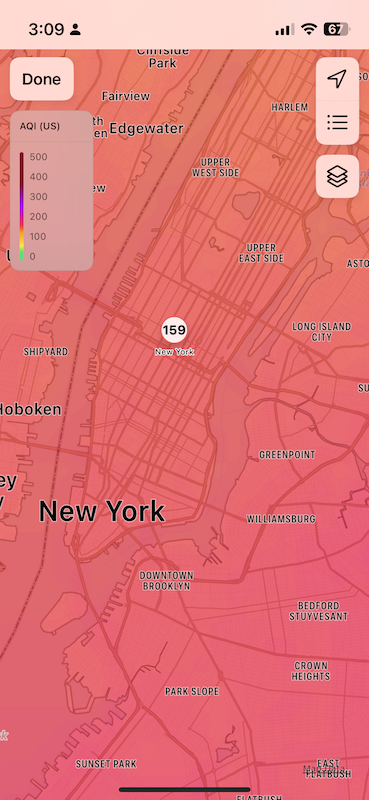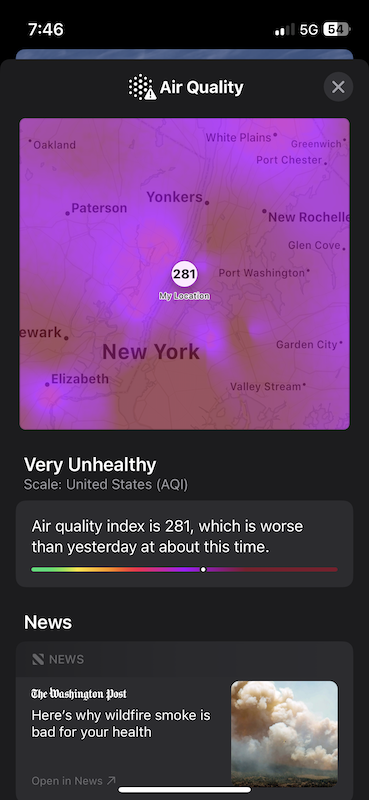Air Pollution in New York | Lessons from the 2023 Canadian Wildfires

Air Pollution in New York | Lessons from the 2023 Canadian Wildfires
In early June, massive wildfires broke out in Canada, sending thick smoke drifting into New York State — creating a surreal, orange-tinted sky across the city. For the first time in memory, the sun appeared as a red disc behind a smoky haze, and the air quality reached hazardous levels.
People with respiratory or heart conditions were strongly advised to stay indoors, and warnings were issued for families with small children.
Even for those accustomed to New York’s urban life, this air pollution felt suffocating — especially for those, like me, who grew up surrounded by nature.
When New York Turned Orange

During the first week of June, the Air Quality Index (AQI) in New York skyrocketed to dangerous levels.
The streets were empty, and the city seemed to pause under a smoky orange sky.
Here’s a video showing the surreal atmosphere that week:
YouTube: NYC Air Pollution June 2023

By the end of the month, another round of Canadian wildfires once again sent smoke drifting into New York.
Even indoors, the air smelled of burning wood.
Despite closed windows, fine particles — known as PM2.5 — managed to enter homes.
Ordinary masks couldn’t block these microscopic pollutants; only N95 masks were effective.
Rethinking Our Eco-Lifestyl
This level of air pollution in New York City is truly unprecedented.
It’s a clear sign that global warming is intensifying.
While Japan experiences heavier rainfall, Canada suffers from record heat and dryness — both consequences of climate change.
We can no longer rely on “small steps.” Each of us must take meaningful action toward sustainable living.
If we don’t, the “point of no return” — when global temperature rise becomes irreversible — may already be upon us.
Plant More Trees in New York
To combat air pollution, one of the most powerful actions is simple: planting more trees.
Trees naturally filter pollutants and improve air quality.
Your food waste can become compost — a natural fertilizer to help city trees grow stronger.
Read more here:
How to Compost in New York City
Reduce Landfill Waste
We can’t directly control the smoke coming from Canada, but we can reduce our local impact.
Every landfill expansion means cutting down more trees to make space for garbage.
Ask yourself:
- Are you minimizing waste at home?
- Are you disposing of hazardous materials properly?
- Are you reducing what you throw away?
Even small efforts add up — composting, recycling electronics, or avoiding disposable plastics are all important steps.
The Hidden Cost of Fast Fashion
Where do your clothes come from?
Brands like H&M and ZARA, as well as luxury labels, produce massive amounts of clothing every season. Unsold inventory is often sent to landfills, worsening environmental destruction.
We can make better choices by supporting eco-conscious brands and second-hand stores.
One inspiring example is Patagonia, which transitioned into a nonprofit organization in 2022, dedicating all profits to environmental protection.
Repairing and reusing clothes is not only sustainable — it’s stylish.
In New York, many artists proudly wear vintage and upcycled fashion. The age of overconsumption is over; true elegance lies in mindfulness.
Final Thoughts
Living in New York during severe air pollution is exhausting — even stepping outside feels risky.
But the real cause isn’t Canada’s wildfires alone.
It’s our collective impact on the planet through global warming.
Small gestures are no longer enough.
It’s time to take real action — for the Earth, for New York, and for ourselves.
Let’s breathe cleaner air together.


